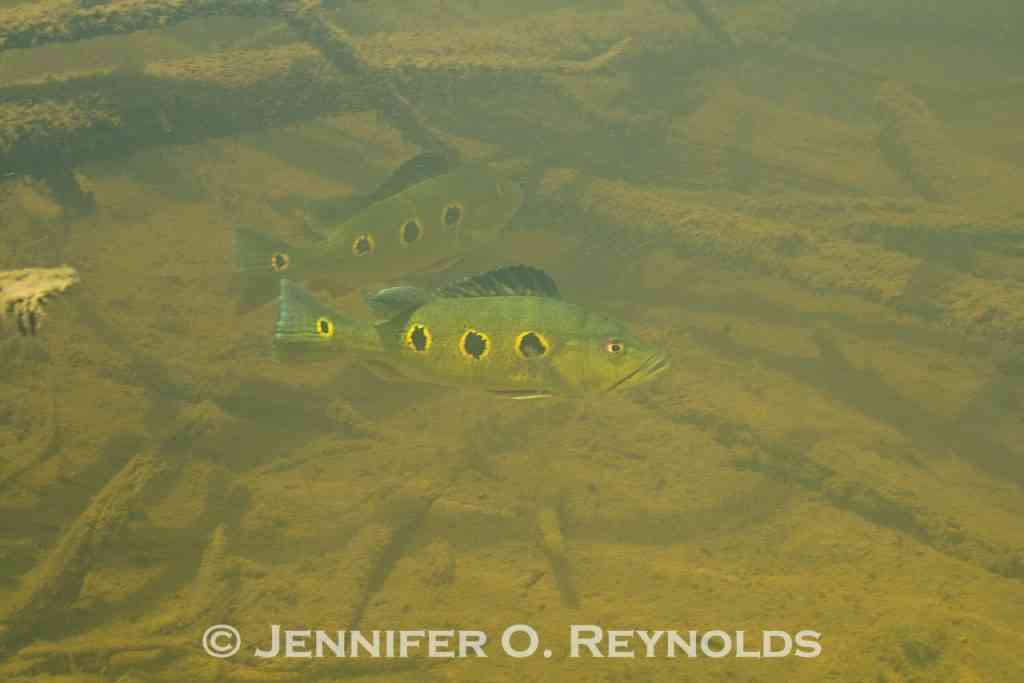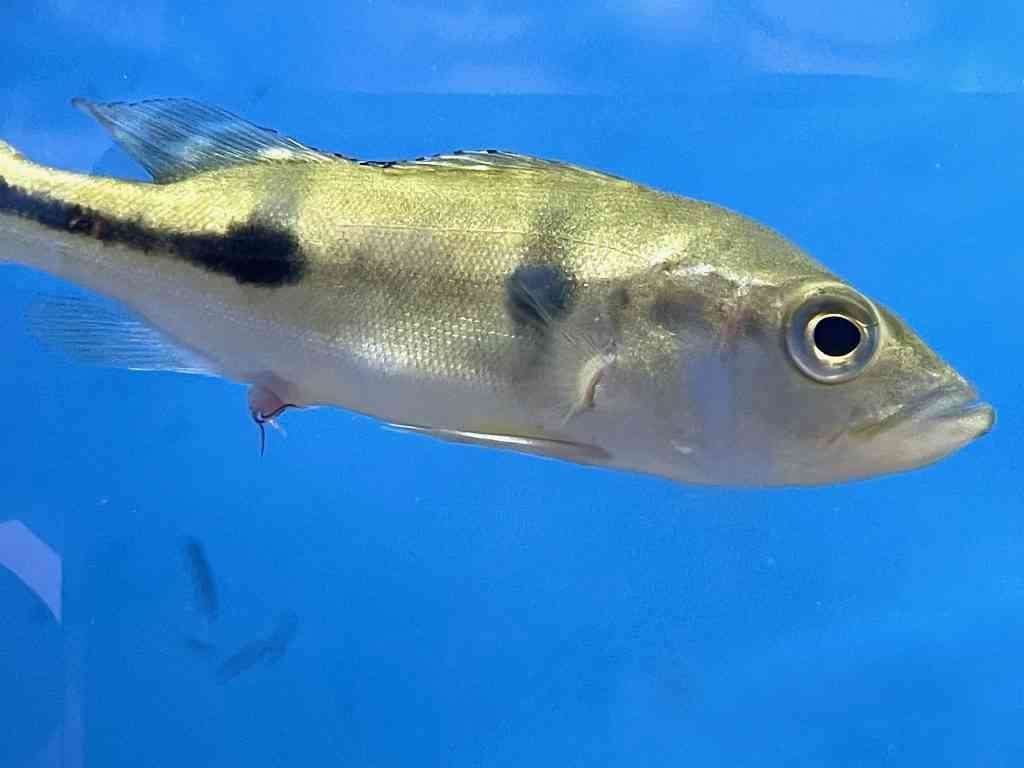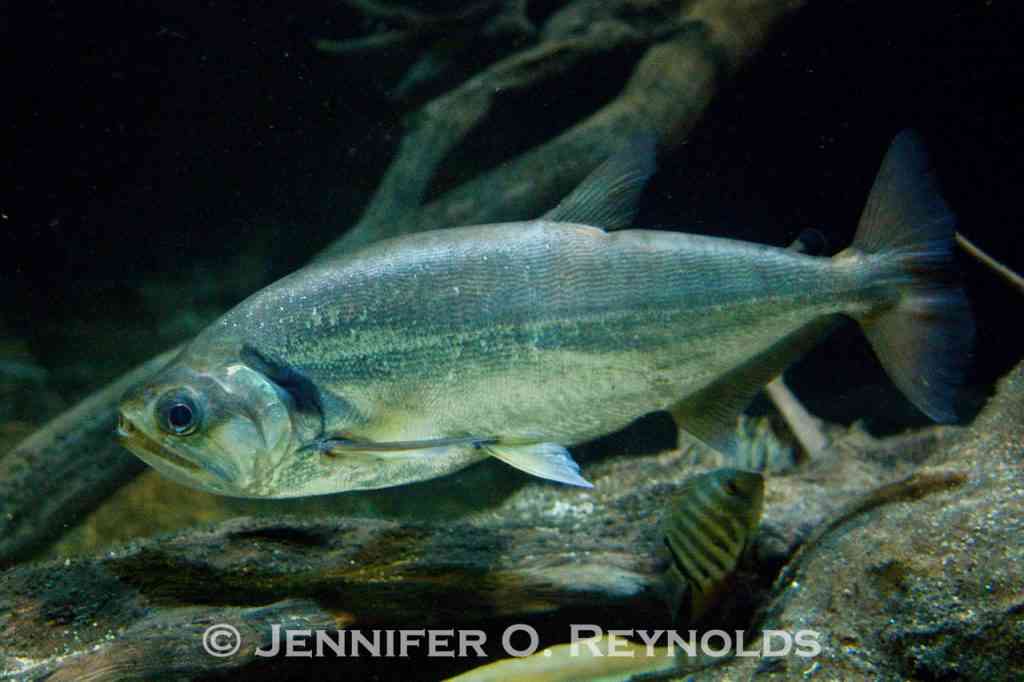Nora Hickey, D.V.M. & Jennifer O. Reynolds, M.A.
Nora and Jen chat about their experiences with internal parasites in aquarium fishes such as Capillaria and Camallanus worms, discussing observation of infected or skinny fish, diagnosis, treatment methods, and the most susceptible species.

Nora: Jen, we had an exciting parasite sighting at a fish store we visited the other day. It’s time to talk worms!
Jen: We sure did! Walking by a tank of juvenile peacock bass (Cichla sp.), I noticed they appeared emaciated, which was surprising to me because they should be aggressive feeders that grow quickly.
You and I have seen these fish together while snorkelling in the Amazon. They’re among the largest of the cichlid species, second only to the Tanganyikan Emperor cichlid (Boulengerochromis sp.), so they get very big, are aggressive hunters and are loved for sportfishing as they’ll strike and make for an exciting fishing experience. I initially assumed they were skinny because they must not have been getting the right food or maybe were starved too much in transit, but Dr. Hickey was on the case and when you looked, you noticed the reason…
Nora: Worms! We looked closely and saw several roundworms protruding from the vent of one of the peacock bass. The worms were a red-brown color and big enough that they could be seen with the naked eye. There are many different fish species in the hobby that tend to have problems with roundworms, so I think this little peacock bass was a sign that it’s time for us to cover this topic!

Jen: I don’t think I’ve ever seen such a heavy and visible infestation as what we saw on that peacock bass. It certainly explains why the fish were emaciated. I wonder if they could have gotten those from being fed live feeder fish. We figured the worms were most likely Camallanus, often called red worms, right? What are the usual routes of initial infection?
Nora: The worms we saw were definitely nematodes, or “roundworms.” These are a type of parasitic worm that affects fish, but also commonly affects other animals including dogs, cats, and horses. Because these worms were reddish and protruding from the fish’s vent, I have a strong suspicion they were Camallanus; but we would need to look at them more closely with magnification to properly identify them.
Roundworms are a common parasite of many different types of fishes—both freshwater and marine. Most commonly, they have a complex life cycle requiring an intermediate host (usually an invertebrate) where the worms undergo some maturation and then a final host where the worms completely mature and are able to reproduce. This is the case for many species of Camallanus, which commonly require a copepod as an intermediate host; when fish eat an infected copepod, they become the final host for this parasite.
However, some nematodes can be directly transmitted from one fish to another with no requirement for an intermediate host. Some Capillaria species are examples of roundworms that can move directly from fish to fish, with no need for an intermediate host. Nematodes with a direct lifecycle like Capillaria can really take off in a system, because they are not dependent upon an invertebrate host to be present to reproduce.
Jen, what are some of the fish species you think of as being particularly susceptible to nematode infestations?
Jen: I’ve had experience with these infestations in fish I cared for at the Aquarium; typically, in new arrivals still in quarantine. Because we could submit any mortalities for histopathology to look for the cause of death, we were often able to confirm the exact species of worm responsible.
We had a large group of wild angelfish with Capillaria, and I also had Hydrolycus sp. (the vampire tetra) with Camallanus. I have noticed that fish who have been fed feeder fish, often feeder guppies, like the Hydrolycus were before we adapted them to frozen food, seem very susceptible to infestation with Camallanus. In both cases, treatment was pretty involved because we were directed to administer oral medication.
Nora: A lot of common live foods, including tubifex worms, can be a source of roundworm infestations.
Jen: Yes, that’s interesting, because live foods can be so beneficial, as we have spoken about. I think that really highlights the importance of having your own established and healthy culture of live food, whether it is black worms, tubifex, feeder fish, or other common live foods.
Nora: I think one of the highest-risk live food types for many pathogens, including roundworms, is feeder fish.
Jen: I agree. Live feeder fish are sometimes necessary, especially when acclimating a wild piscivorous specimen, but I always place high importance on introducing frozen foods or even gel diets as soon as possible and phasing out the live fish. There are some species I adore, like the Amazon Leaffish (Monocirrhus polyacanthus) which are extremely difficult to maintain without live feeder fish, so I just don’t keep them anymore.

Nora: It’s a reason to be very selective about your live food sources for your fish. And in general, frozen versions of common live foods are less likely to have pathogens such as roundworms because freezing kills them (or at least greatly reduces the infectious dose even if some of the nematodes survive freezing).
Feeding formulated or frozen foods is an important step to avoiding Camallanus infestations. If you are feeding live foods, maintaining your own cultures and purchasing from a trusted source are very important. But of course, in the case of that peacock bass, if you are purchasing wild-caught specimens, you are likely to run across fish infested with roundworms like Camallanus.
Jen: And I’d hazard a guess they were being fed feeder guppies or some other feeder fish at the store, too.
Nora: Probably!
Jen: So, reducing a source of ongoing or future infestation by acclimating to prepared foods is important, but so is treatment of the existing infestation. This can be a tricky one.
Nora: Nematode infestations in fish are often treated with the same drugs used for dogs and cats. Anthelmintic drugs such as fenbendazole, levamisole, and ivermectin treat nematodes and can be incorporated into the food, injected, or dissolved in the water. It’s a dilemma that fish eating live foods are the most likely to have roundworm infestations, because these fish can be the trickiest to treat for roundworms, with a lot of time and energy spent figuring out how to get the medication into their very special food items!
And this problem is not just limited to fish eating live foods. I saw a case of bristlenose catfish (Ancistrus spp.) with a nematode infestation. Of course, these fish weren’t eating live foods, but loricariids have their own challenges with respect to administering medication in their feed since they are algae eaters and primarily consume plants and driftwood. I don’t think anyone has figured out how to bioaccumulate anthelmintic drugs in algae or driftwood yet!
Jen: Were they wild-sourced fish or captive-bred?
Nora: These fish were captive-bred. Ancistrus are susceptible to the roundworm Capillostrongyloides ancistri, which can be transmitted directly from one fish to another without any need for an intermediate host. Nematodes with this direct life cycle can persist for years in captive-bred fish populations.
Jen: Yeah, that would be a tough one! Maybe a gel diet?
Nora: A gel diet would have been a solid option, but we ultimately recommend a levamisole bath treatment.
Jen: That way you can control the dose as well. It would be difficult to ensure the right amount of medication would be administered to a loricariid catfish slowly grazing on gel.
Nora: Yes, it would be so hard to know how much these reclusive little guys were eating! Unfortunately, there was no follow-up for this case, but I wonder about the efficacy of a bath treatment for parasites living in a fish’s intestines—I don’t think the drug ends up where it needs to be nearly as well as when administered in the feed.
Jen: Great point.
Nora: Another concern I had was the hygiene. These fish were living in an environment with a lot of sediment and organic debris, and some of the roundworm eggs and larvae may have been able to survive treatment. Maintaining excellent hygiene is a critical part of both preventing and treating any roundworm infestation.
Jen: So even if the first treatment worked in the gut of the fish, they could have been infected again?
Nora: Exactly. Frequent vacuuming and removal of organic debris is important: especially feces, where the worms are present in very high numbers.
Jen: I see this as an example of why quarantine tanks can have such an important role in managing and preventing parasites like this from infesting an entire established community of fish. Introducing one fish with a worm infestation into an established aquarium could wreak havoc.
Nora: Yes, it could. Especially for species such as angelfish and zebra danios, which are commonly infested with nematodes.

Jen: When I was working at the Aquarium, I had to deal with the surprisingly tricky scenario of medicating the wild angelfish (Pterophyllum scalare) for Capillaria. We were advised to orally dose Panacur. However, it was a very large group of fish, who were very picky about food and would not eat a prepared gel diet, which is typically the easiest way to administer medications. As a side note, this is one of the key reasons why I made sure that every fish in our collection would eventually eat a gel diet—to make sure we could not only supply complete nutrition but also medicate if needed.
In any case, since the angelfish were eating frozen adult brine shrimp, what we did was order live adult brine shrimp and gut load them with the medication, by dispersing it in the water column in a bucket of them, since they filter particles out of the water! Then we froze those brine shrimp once their guts were full of the white Panacur, and used them as a medicated food source. Being an aquarist requires a lot of creative problem-solving and really knowing your species!
While nematode infestations can become really problematic in our aquariums, I know that it’s pretty normal for wild fish to harbor a number of different parasites, including internal ones, throughout their lives. Why is it that these infestations become such big problems in an aquarium versus in a fish living in the wild?
Nora: One reason is that the fish are in a more contained environment, where the parasite can more easily infest them and replicate. This is particularly true for the nematode Pseudocapillaria tomentosa that infests zebrafish. Because it can be transmitted directly from fish to fish, an aquarium is a great environment for it to take off.
Jen: Sort of a free-for-all for the parasites.
Nora: A terrifying situation to develop in your fish tank! The good news is that the clinical signs caused by roundworms such as Camallanus and Capillaria are usually mild, and fish are likely to do very well after receiving proper treatment. Some of the other fish pathogens we have discussed can cause quite heavy mortality, but roundworm infestations are more likely to present like the peacock bass we saw at the fish store: skinny fish that “aren’t doing right.”
Jen: By the time fish are so emaciated and have such a heavy infestation as we saw in the peacock bass, intervention really is required. In the case of the Hydrolycus at the Aquarium that had Camallanus, we were advised to give an oral dose of Panacur. The tricky part was how to administer it! I think I may be one of not-that-many humans who have tube-fed a Hydrolycus. We prepared the paste, anesthetized the fish, and used a thin tube on a syringe to get it right into the fish’s stomach. Otherwise, since at the time they only ate live feeder fish, there was no practical way to get the required dose in there!
Nora: This is so ridiculously cool! I need to take a moment to fully appreciate the image of you tube feeding a Hydrolycus. I hope this particular professional skill is listed at the very top of your resume. You have some serious aquarist street cred.
Jen: There were so many cool, bizarre and memorable experiences, and this one was no exception. To be fair, it was but a wee vampire tetra, under 5” at that point. Still, they have some serious teeth! It was cool to get an up-close look at them, too.

Nora: For those of us who aren’t trying to medicate vampire tetras via feeding tube, a more typical approach to treating nematodes in fish in a home aquarium might be incorporating the anthelmintic drugs fenbendazole or levamisole into food or doing a bath treatment with levamisole in the water. There are a number of resources available that provide specific information about treatment dosage and frequency as well as how to prepare the food.
As I mentioned earlier, many nematode infestations cannot be diagnosed just by looking at the fish. Many different diseases besides roundworm infestations can cause skinny fish, such as mycobacteriosis, microsporidian infections, and of course improper feeding and husbandry. Definitively diagnosing a roundworm infestation requires microscopic examination of a fecal sample or a necropsy of an affected fish. Nematodes like Capillaria and Pseudocapillaria are much smaller than Camallanus and can’t be seen with the naked eye the way that we saw the Camallanus in the peacock bass.
Jen: Interesting…and that does follow with my experience with Capillaria. The only thing I noticed with those wild angelfish was chronic skinniness that wasn’t resolving with loads of good food, and eventually, the mortalities that we sent for examination before getting our diagnosis. For most fishkeepers, any fish that is very skinny should be avoided when purchasing or acquiring new fish, unless there is a good explanation for it. Any fish that fails to develop good body condition when given a good diet and living quarters should also be questioned as to what is really going on.
Nora: If you have a skinny fish that you are concerned about, I strongly recommend working with a veterinarian. A veterinarian can perform tests to correctly diagnose the problem, and they can access medications (many of which are not available over the counter) to safely and effectively treat roundworm infestations. Some anthelmintics, especially ivermectin, can be toxic at very low doses, so there are risks to doing these types of treatment. However, for some fish species—especially wild-caught fish and fish that are eating live foods—routine deworming could be an important part of successfully keeping them.
Jen: Overall, using quarantine, avoiding acquiring skinny fish and avoiding using live foods when not from an established home culture are all ways to reduce the risks of these types of worms in a home aquarium. And if you do suspect an infestation, the best scenario is to seek a diagnosis and treatment recommendation from a veterinarian
Reputable Resources:
Noga EJ. Fish Disease : Diagnosis and Treatment. Second edition. Wiley-Blackwell; 2010.
Nematode (Roundworm) Infections in Fish, University of Florida Tropical Aquaculture Laboratory Extension Publication.

